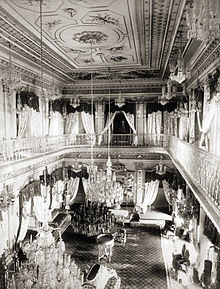Asaf Jah V.
Mir Tahniath Ali Khan Afzal ad-Daulah Mahbub Ali Khan Asaf Jah V. (* October 11, 1827 - February 26, 1869 ), GCSI was the absolutist ruler of the Indian princely state of Hyderabad . Under his mighty Diwan Salar Jung I , reforms of the state administration, such as the division of the country into districts, were introduced. The reforms put public finances on a modern, solid foundation. His main wife was the Wadid-u-Nisa Begum.
Domination
Since 1853 the administration of the country was under Salar Jung I, who had started to control the state finances by introducing bookkeeping. At this time the finances were shattered by the numerous middlemen and the inherent corruption of the Muslim despotic system of rule. Torture was not abolished until 1865.
Shortly after his enthronement, the Sepoy Uprising broke out. The Nizam was threatened in its position by the followers of Shah Waliullah, the Wahhabis , who preach a particularly puritanical interpretation of Islam. The Rohillas insurgents attacked on July 17, 1857 the seat of the resident Cuthbert Davidson (* 1810, † 1862). However, Salar Jung had learned of the plans and warned the British so that they could repel the attack under the command of Colonel Briggs. The colonial rulers believed that the fact that the Nizam did not show the slightest sympathy for the insurgents prevented the uprising from spreading to southern and western India. The Hyderabad Contingent , which was stationed in Secunderabad and paid for by the Nizam, was subordinate to the British and fought the insurgents in the Bombay presidency for the following 15 months , also remained loyal .
Diplomacy was actually due to the Diwan, but it was ascribed to the ruler who, after 1858, was allowed to call himself “Faithful Ally of the British Government”. As a further reward, he received ½ million debts in 1861 and received the surpluses from Berar and the Sholapur area.
The Nizam itself took little part in the government business, which was incumbent on the energetic Diwan, who managed to forty-fold the income of the state in the 30 years of his tenure, and who was the regent of Asaf Jah VI. from 1869 held power in his hands. The Chowmahalla Palace , an example of extreme oriental splendor, begun around 1750, was completed during his reign. After paying rent and taxes, the country's farmers rarely had a third of their harvest left.
He was buried in the capital's Mecca mosque .
literature
- VK Bawa: The Nizam between Mughals & British: Hyderabad under Salar Jang I. New Delhi 1986. 2nd edition 1996 under the title: Hyderabad under Salar Jang I.
- Hastings Fraser: Our Faithful Ally . London 1860 ( full text ; reprint Delhi 1985)
- Bharati Ray: Hyderabad and British paramountcy, 1858-1883 . Delhi u. a. 1988, ISBN 0-19-562231-6 ( e.g. Calcutta Univ., Diss. UdT: British policy towards Hyderabad )
- Hyderabad (Deccan) under Sir Salar Jung . archive.org
Web links
- Pedigree of the Dynasty (English)
Individual evidence
- ^ Author of: Henry G. Briggs: The Nizam: his history and relations with the British government . London 1861, 2 volumes. reprint Delhi 1985
- ↑ U. Aitchison: A collection of treaties, engagements, and sunnuds relating to India and neighboring countries . Calcutta 1876, p. 222: Treaty of December 31, 1860
| personal data | |
|---|---|
| SURNAME | Asaf Jah V. |
| ALTERNATIVE NAMES | Afzal ad-Daulah Mahbub Ali Khan |
| BRIEF DESCRIPTION | fifth nizam of the Indian princely state of Hyderabad (1857–1869) |
| DATE OF BIRTH | October 11, 1827 |
| DATE OF DEATH | February 26, 1869 |


